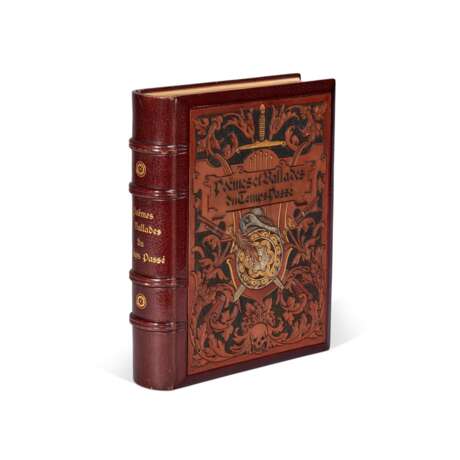Christine de Pisan, and others | Poëmes et ballades du temps passé. Paris, 1902, with original illustration and bound by Meunier
28.11.2023 14:00UTC +00:00
Classic
Prix de départ
3000GBP £ 3 000
| Auctioneer | Sotheby´s |
|---|---|
| Lieu de l'événement | Royaume-Uni, London |
Archive
La vente aux enchères est terminée. Vous ne pouvez plus enchérir.

ID 1073315
Lot 26 | Christine de Pisan, and others | Poëmes et ballades du temps passé. Paris, 1902, with original illustration and bound by Meunier
Valeur estimée
£ 3 000 – 5 000
Poëmes et ballades du temps passé. Paris: Imprimé pour Charles Meunier “Maison du Livre”, 1902
NUMBER 53 OF 115 COPIES, 100 of which were for sale, small folio (320 x 233mm.), text printed in red and black, woodcut tailpieces by Pierre Gusman, and 50 large etchings by Albert Robida beginning each of the poems and ballads, and (bound in at the back) an extra suite of the tailpieces on China paper as well as an extra suite of the etchings in two states (black and bistre) on China paper, and (tipped in at the front) A FINE FULL-PAGE ORIGINAL SIGNED PEN AND WASH PAINTING IN SEPIA TONES BY ROBIDA, A “CUIR CISELÉ” BINDING OF MAHOGANY MOROCCO OVER HEAVY BEVELLED BOARDS BY CHARLES MEUNIER , BOTH COVERS WITH ELABORATELY DETAILED SCULPTED SCENES filling a large brown calf panel: upper cover featuring a golden sword hilt at the top middle and a skull at the foot, a large lyre at the center acting as scabbard and incorporating a cartouche bearing the title, and beneath that a shield and a troubadour’s hat over crossed rifles and swords, all highlighted with silver or gold paint; lower cover with similar elements but very differently designed, featuring cuir ciselé acanthus leaf cornerpieces and a large centrepiece medallion, the centrepiece with a shield over two crossed swords and a lance, a lute, and horn hanging from the latter, these elements highlighted with silver or gold paint and encircled by a laurel branch; raised bands, centre spine panel with gilt titling, panels above and below it with simple gilt floral medallion, turn-ins consisting of light brown morocco punctuated with inlaid mahogany morocco ovals, gold watered silk endleaves, marbled flyleaves, all edges gilt, original pictorial paper wrappers bound in, with additional state of illustrated wrapper featuring Meunier’s windmill device in place of the title
This collection of French Medieval and Renaissance poems and romantic ballads by various authors provides an appropriate vehicle for displaying the artistry of illustrator Albert Robida (1848-1926) and the celebrated binder Charles Meunier (1865-1940). Meunier’s typically animated and delightful binding incorporates symbols of the era of troubadours into an exuberant Art Nouveau design, and the volume is a very successful example of the “cuir-ciselé” (or “incised leather”) technique for which our binder is particularly well known. Meunier was legendary among French binders of the late 19th and early 20th centuries for his energy and imagination. Apprenticed to Gustave Bénard at the age of 11, he worked for a time in the atelier of Marius Michel, and then set up his own studio when he was 20. According to Duncan & De Bartha, he drew “on both traditional and modern techniques and forms of decoration, [mixing] classical punches… with newly fashionable incised and modelled leather panels.” This eclectic approach did not lead to the kind of popularity enjoyed by some of the binder’s most distinguished competitors, and partly as a protest in recognition of this, “Meunier declined to participate in the 1900 Exposition, as he felt that the Grand Prix would automatically be awarded to Marius Michel (which it was). He staged his own show at his studio on the Boulevard Malesherbes and received as much magazine coverage as the participants at the Exposition.” He retired from active binding in 1920. This work was printed for Meunier, who seems to have had near total artistic control of the project. He chose the prolific and talented painter, caricaturist, and illustrator Albert Robida to do the etchings, perhaps because Robida was especially noted for his depictions of Medieval life and costume. His style is perfect for interpreting the works of such early French writers as Jehan de Meung (1260-1320), Christine de Pisan (1363-1420), and
François Villon (1431-1500). The original watercolour here is not a design that appears anywhere in the book, although it is in the same style. It was possibly meant to serve as the basis for another illustration in this work that was not included among the final set of plates.
| Catégorie maison de vente aux enchères: | Impressions, graphiques, livres |
|---|
| Catégorie maison de vente aux enchères: | Impressions, graphiques, livres |
|---|
| Adresse de l'enchère |
Sotheby´s 34-35 New Bond Street W1A 2AA London Royaume-Uni | |
|---|---|---|
| Aperçu |
| |
| Téléphone | +44 (0) 20 7293 5000 | |
| Téléphone | +1 212 606 7000 | |
| Conditions d'utilisation | Conditions d'utilisation |




